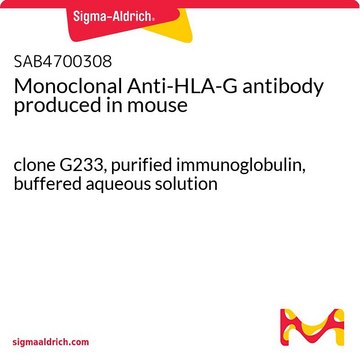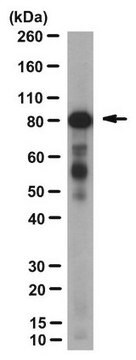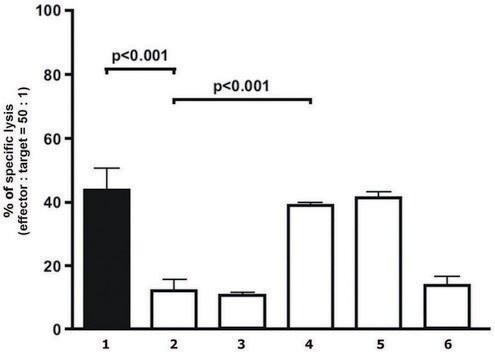SAB4700310
Monoclonal Anti-HLA-G antibody produced in mouse
clone MEM-G/9, purified immunoglobulin, buffered aqueous solution
Faça loginpara ver os preços organizacionais e de contrato
About This Item
Código UNSPSC:
12352203
NACRES:
NA.41
Produtos recomendados
fonte biológica
mouse
Nível de qualidade
conjugado
unconjugated
forma do anticorpo
purified immunoglobulin
tipo de produto de anticorpo
primary antibodies
clone
MEM-G/9, monoclonal
Formulário
buffered aqueous solution
reatividade de espécies
human
concentração
1 mg/mL
técnica(s)
flow cytometry: suitable
Isotipo
IgG1
nº de adesão NCBI
nº de adesão UniProt
Condições de expedição
wet ice
temperatura de armazenamento
2-8°C
modificação pós-traducional do alvo
unmodified
Informações sobre genes
human ... HLA-G(3135)
Categorias relacionadas
Descrição geral
The antibody MEM-G/9 reacts with native form of human HLA-G1 on the cell surface as well as with soluble HLA-G5 isoform in its beta2-microglobulin associated form. HLA-G belongs to the MHC Class I molecules (MHC Class Ib; nonclassical) and it is expressed on the surface of trophoblast cells. The antibody MEM-G/9 is standard reagent thoroughly validated during 3rd International Conference on HLA-G (Paris, 2003).
Imunogênio
Recombinant human HLA-G refolded with beta2-microglobulin and peptide
Aplicação
The reagent is designed for Flow Cytometry analysis. Suggested working dilution is 2 μg/mL of sample. Indicated dilution is recommended starting point for use of this product. Working concentrations should be determined by the investigator.
Características e benefícios
Evaluate our antibodies with complete peace of mind. If the antibody does not perform in your application, we will issue a full credit or replacement antibody. Learn more.
forma física
Solution in phosphate buffered saline, pH 7.4, with 15 mM sodium azide.
Exoneração de responsabilidade
Unless otherwise stated in our catalog or other company documentation accompanying the product(s), our products are intended for research use only and are not to be used for any other purpose, which includes but is not limited to, unauthorized commercial uses, in vitro diagnostic uses, ex vivo or in vivo therapeutic uses or any type of consumption or application to humans or animals.
Não está encontrando o produto certo?
Experimente o nosso Ferramenta de seleção de produtos.
Código de classe de armazenamento
10 - Combustible liquids
Ponto de fulgor (°F)
Not applicable
Ponto de fulgor (°C)
Not applicable
Escolha uma das versões mais recentes:
Já possui este produto?
Encontre a documentação dos produtos que você adquiriu recentemente na biblioteca de documentos.
Jay M Bolnick et al.
Fertility and sterility, 102(1), 135-142 (2014-05-16)
To use trophoblast cells accumulating in the endocervical canal at the beginning of pregnancy for noninvasive prenatal testing. Prospective, double-blinded test for fetal gender. Academic medical center. Fifty-six women with singleton pregnancies at gestational age 5-20 weeks. Isolation of fetal
Ana S López et al.
Molecular immunology, 43(14), 2151-2160 (2006-02-24)
Dendritic cells (DC) are strong inducers of immunity but they can also be tolerogenic. During monocyte differentiation to DC the immunosuppressive indoleamine-2,3-dioxygenase (IDO) is induced. IDO degrades Trp to kynurenine, which is further metabolized to 3-hydroxyanthranilic acid. DC can also
Nele Gao et al.
Arthritis & rheumatology (Hoboken, N.J.), 66(10), 2849-2861 (2014-06-20)
B cells with immunoregulatory properties (Breg cells) have been described in mice, but their role in the control of human immune responses is not well defined. We recently identified a human population of activated FSC(high) B cells that exhibited regulatory
Natasja Nielsen et al.
Immunology, 142(4), 581-593 (2014-03-29)
Rheumatoid arthritis (RA) is an autoimmune disease characterized by chronic inflammation and synovial hyperplasia leading to progressive joint destruction. Fibroblast-like synoviocytes (FLS) are central components of the aggressive, tumour-like synovial structure termed pannus, which invades the joint space and cartilage.
Nossa equipe de cientistas tem experiência em todas as áreas de pesquisa, incluindo Life Sciences, ciência de materiais, síntese química, cromatografia, química analítica e muitas outras.
Entre em contato com a assistência técnica








